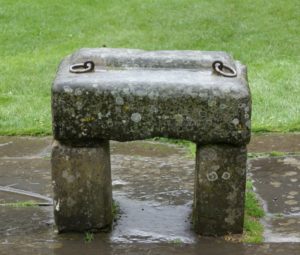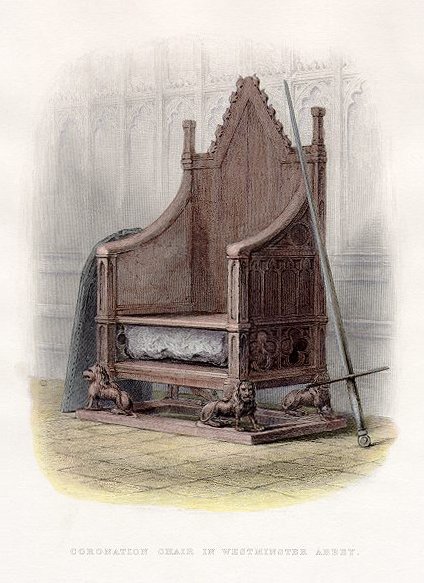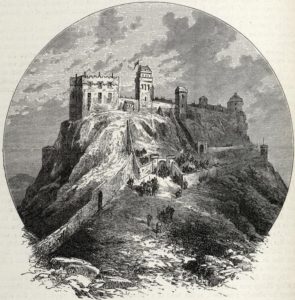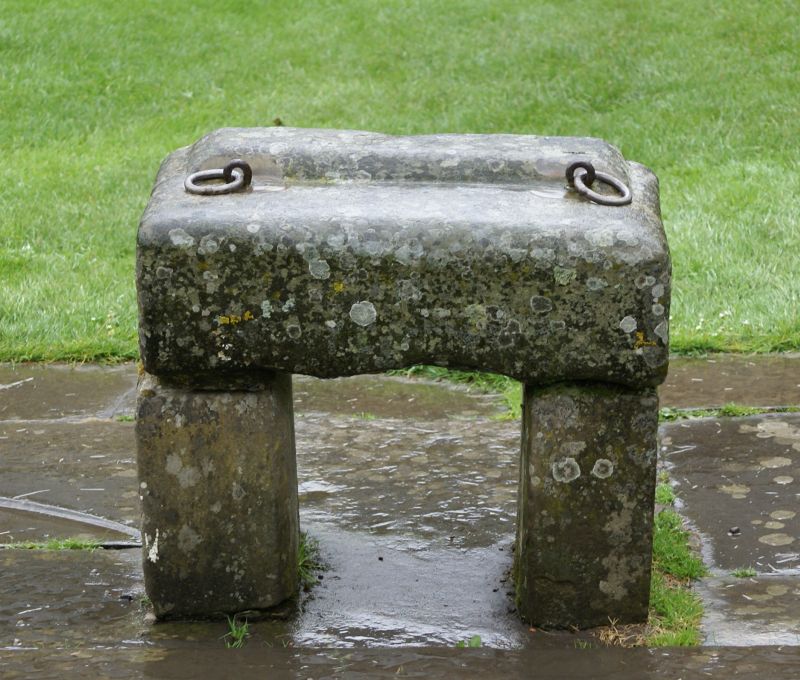
The Stone of Destiny
by Duncan Burden
When is a found treasure, still a lost treasure?
Such is the question with the famous The Stone of Scone – The King Maker Stone.
In reality all that is being discussed here is an oblong block of red sandstone. It is around 26 inches (660 mm) wide by 16.75 inches (425 mm) depth by 10.5 inches (270 mm) high. It weighs approximately 336 pounds (152 kg). A roughly incised cross is on one surface, and iron rings at either end, from which it used to be carried.
Yet, it is one of the prize Crown Jewels of England, and now under the protection of Scotland. For this stone holds an almost legendary importance in the ceremonial ritual of the coronation of Monarchs in the United Kingdom – but the question is asked, is the stone presently guarded under Royal Warrant, the real Stone – or is the real Stone buried or secretly stored, and a lost treasure to find?
First to the Stone itself, which is known by various names, in the Scottish Gaelic tongue it is ‘An Lia Fàil’ or ‘clach-na-cinneamhain’, in common Scots it is called ‘Stane o Scuin’ – the Stone of Scone. It is also known as Jacob’s Pillow, the Tanist Stone, the Stone of Destiny and The Coronation Stone.
There are various legends about the origin of the stone. One story tells of how the first King of Scotland, Fergus, the son of Erc, brought the stone from Ireland to Argyll, and was crowned. The romantic notion is that Fergus brought the stone in the essence of being a seed of the ‘Lia Fáil’, the coronation stone of the ancient Irish Kings, their own Stone of Destiny. The term ‘Fáil’ literary means ‘destiny’, as the ‘Inis Fáil’(The Island of Destiny) is one of the traditional names of Ireland.
Another legend supposedly takes the origin of the stone all the way back to Biblical times, making it the stone that Jacob rested his head when he dreamt of ascending to heaven.
Yet, it is its use as a sacred stone that marked the rightful anointment of King, and later Queen, for which its value lies. It is in a 14th century account written by the English cleric and historian, Walter Hemingford, that appears to be the first actual record of the Stone being used specifically in coronations. He writes at this time with assertion that this has been its purpose for centuries. Considering the similar use of such stones has a long history in Ireland and has strong ancient Celtic ties with Scotland, this would not be strange for a similar culture to adopt similar structures of ceremonies. Hemingford states the belief that the stone came from the monastery of Scone, now a ruin but located just north of Perth, Scotland.

Although used centuries to mark the recognition of Scottish Monarchs, it was in the reign of Edward the 1st of England, that the stone was removed from Scotland and taken to Westminster in London. Westminster is the scared location where all English Monarchs are made Kings or Queens. Edward’s intention was to symbolically enforce the recognition of English rule over Scotland, by having a special chair made to house the stone in its base, now called ‘The King Edward’s Chair’. It is from the reign of Edward 1st, that all monarchs of England are crowned whilst seated in this throne.
The first challenge to the actual authenticity of this Stone, comes from the reign of Edward and his orders to move the Stone to England. A certain logical challenge exists that it is highly probable that as Edward made strong and forceful claims to the lands of Scotland, and was not short in saying he was their King, it would seem expected that those who were protectors of this special Stone, the symbol of how to recognise a Scottish King, was in jeopardy. Someone must have thought that Edward would either destroy it, to symbolically stop any native challenger, or have it removed to deny the symbolic acceptance of a challenger. Surely, someone would have thought to try and practically protect it – and what better way to add insult to injury, but that to make a fake stone.
A stories even exists that when the orders of the Stone’s removal came, the monks of nearby Scone Palace took the true stone and hid it in the River Tay, or, in some accounts, buried it on Dunsinane Hill.
With modern technology, curiously, Geologists have tested the Westminster Stone, and have proved that it is what is called ‘lower old Red Sandstone’, a type of stone quarried in the very vicinity of Scone. As such, either the original stone did indeed come from Scone and not brought from Ireland, or a ‘replacement’ was quickly made from local stone.
This is not the only possible act of protecting national heritage and tradition that brings the authenticity of the Westminster Stone into question.
On Christmas Eve of 1950, an Ian Hamilton, who was studying law at the University of Glasgow, jeopardized his future career, and broke into Westminster Abbey. He successfully removed the Stone and returned the item to Scotland.
In preparation for the heist, Hamilton had scouted the Abbey some days before and noted one of the side doors was made of soft pine rather than the traditional strong Oak, and it was via this that he, and his accomplices Kay Matheson, Alan Stuart, and Gavin Vernon, managed to steal away the relic.
Unfortunately, the process of removing the stone from the throne, it supposedly fell and, besides breaking two toes of one of the conspirators, broke into two pieces.
Hamilton was eventually caught, as it seemed obvious that a Scotsman was guilty of the theft, so the police visited the Scottish libraries to see if anyone had shown specific interest in researching the Stone and its English location. This proved successful as the records of the Mitchell Library of Glasgow showed that Hamilton, in the process of his research, had checked out every single book the library had on Westminster Abbey.
It was on April 11th, 1951, at the Abbey of Arbroath, that Hamilton, with others, returned a ‘repaired’ Stone to the authorities. The question existed that the ‘repaired’ stone was not the original.

Indeed Hamilton’s act could be put down as simply being a lavish student prank, until it is realised that he had procured, or been paid, fifty pounds (the equivalent of around thousand pounds today) from Scottish National Party leader John MacCormick for the daring scheme, adding fuel to the thought that the real stone was never returned.
Eventually the Stone was officially returned to Scotland in 1996, when on the 15th November a ‘handover’ ceremony was performed on the border of England. The Stone was transported to Edinburgh Castle, when on the 30th November, St. Andrew’s Day – the Patron Saint of Scotland, there was another, more official handover ceremony carried out with Prince Andrew, Duke of York, representing the Her Majesty, Queen Elizabeth II, during which he also passed over the Royal Warrant, declaring the protection of the Stone to the Commissioner for the Regalia, and thus it became part of the crown jewels of Scotland.
The question remains if that Stone is still the original, or if the true relic is buried or revered somewhere else. In the 1950’s a Scotsman was willing to pay the equivalent of £1000 for the Stone, but what if the true historic stone is still to be found and a lost treasure?
~by MW Team Writer Duncan Burden
Copyright 2017 by Duncan Burden. All Rights Reserved.


It’s amazing what history and time can do to an object.
One day in the future they will be able to read information from Nature’s properties. That info won’t be in English like this page of information, it will be non-verbal based in frequency, vibration and light. It will be a knowing instead of knowledge. So authenticity will checked with knowing instead of knowledge.
Are you thinking that maybe the molecules have a way of storing the past like a snapshot?
I like the idea you brought up about molecules. I would guess you need electromagnetism.
That’s a very insightful concept, 23Kachinas.
Nature has many stories to tell. All physical matter is also made of Spiritual Matter…which is only discerned Spiritually.
On a similar note…
http://money.cnn.com/2016/02/17/technology/5d-data-storage-memory-crystals/
5D! Almost like the strange language of the visitors in the movie “Arrival”.
Thanks again for another interesting story, Jenny…
…and on Easter Weekend, too! The Celebration of the Life of THE King.
I mean…Thank you, Duncan…and Jenny. 🙂
Thank you for sharing JC1117. Exactly like this crystal but nature stores intelligence not just information.
Not stores…that sounds static, rather I mean channels and opens unlocked intelligence.